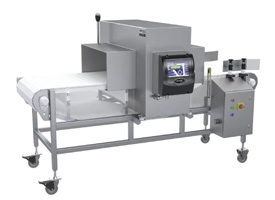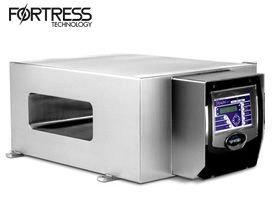Testing Metal Detectors - Fortress Technology

Regardless of how sophisticated or reliable a metal detection system may be, it is essential that a frequent and thorough test and recording program be established. This is an essential component if any quality or HACCP (Hazard Analysis & Critical Control Points) system. In the absence of any industry standards for detector testing, each company must establish their own test criteria. To date, many of the standards adopted have been defined by the major retailers.
The following points should be considered when developing or changing your program:
1) Test Sample
Historically, metal detectors have been tested with a ferrous and non-ferrous, and sometimes a stainless steel test sample. More recently there has been a trend towards using a single, (preferably stainless steel), the test sample in order to simplify the test process.
The size of the test sample must be established so that it can be reliably detected inside the product passing through the centerline of the detector - least sensitive point.
Every application will be different and therefore the samples should be tailored to each detector. If the sample is too small for the application, it will cause unnecessary test failures and create a high frustration level with the test operators. If the sample is too large, it will not accurately test the performance of the detector. Using a selection of test sample sizes, establish a realistic and repeatable operating performance level.
2) Test Frequency
The company management must decide the frequency of testing the detector. Typically, detectors are tested:
There is an obvious tradeoff between the cost of testing versus the risk of potential detector failure. The use of an automatic test system can increase the frequency of detector performance testing at no additional cost.
3) Test Procedure
The procedure itself should be kept as simple as possible, but must take into account the following:
a) The test sample should travel through the approximate centerline of the aperture which is the least sensitive point.
b) The test samples should be placed on the product if possible.
c) The test procedure must allow the reject device to activate so that the entire system is tested.
This can include:
d) The results of the test must be recorded.
4) Test Records A sample of a test record is included for information. The format is not important, however, it should include:
a) Line or detector identification
b) A date and time
c) The sample used
d) Identification of the operator
e) A pass or fail result
f) A corrective action is taken if result was a failure
5) Automatic Test Systems
There are some Automatic Testing systems designed to complement, and in some applications replace manual test procedures. The capability of these systems should be reviewed carefully to ensure that the testing is relevant and feasible for the application. No doubt when installing effectively they can offer considerable savings through reduced labor and material wastage.
SOURCES OF INTERFERENCE
Environmental conditions may affect the performance of the Metal Detector, particularly where high levels of sensitivity are to be achieved. Where ever possible the detector should be positioned to avoid or minimize the effect of such conditions.
These can be generated by a number of sources:
This is an important consideration to be taken into account when comparing the capabilities of detectors.
Source: Fortress Technology
The following points should be considered when developing or changing your program:
1) Test Sample
Historically, metal detectors have been tested with a ferrous and non-ferrous, and sometimes a stainless steel test sample. More recently there has been a trend towards using a single, (preferably stainless steel), the test sample in order to simplify the test process.
The size of the test sample must be established so that it can be reliably detected inside the product passing through the centerline of the detector - least sensitive point.
Every application will be different and therefore the samples should be tailored to each detector. If the sample is too small for the application, it will cause unnecessary test failures and create a high frustration level with the test operators. If the sample is too large, it will not accurately test the performance of the detector. Using a selection of test sample sizes, establish a realistic and repeatable operating performance level.
2) Test Frequency
The company management must decide the frequency of testing the detector. Typically, detectors are tested:
- Shift Change
- Product Change
- Hourly
There is an obvious tradeoff between the cost of testing versus the risk of potential detector failure. The use of an automatic test system can increase the frequency of detector performance testing at no additional cost.
3) Test Procedure
The procedure itself should be kept as simple as possible, but must take into account the following:
a) The test sample should travel through the approximate centerline of the aperture which is the least sensitive point.
b) The test samples should be placed on the product if possible.
c) The test procedure must allow the reject device to activate so that the entire system is tested.
This can include:
- Testing with contaminant at leading and trailing edge
- Testing successive packs
- Testing alternate packs
d) The results of the test must be recorded.
4) Test Records A sample of a test record is included for information. The format is not important, however, it should include:
a) Line or detector identification
b) A date and time
c) The sample used
d) Identification of the operator
e) A pass or fail result
f) A corrective action is taken if result was a failure
5) Automatic Test Systems
There are some Automatic Testing systems designed to complement, and in some applications replace manual test procedures. The capability of these systems should be reviewed carefully to ensure that the testing is relevant and feasible for the application. No doubt when installing effectively they can offer considerable savings through reduced labor and material wastage.
SOURCES OF INTERFERENCE
Environmental conditions may affect the performance of the Metal Detector, particularly where high levels of sensitivity are to be achieved. Where ever possible the detector should be positioned to avoid or minimize the effect of such conditions.
These can be generated by a number of sources:
- Airborne electrical interference - static, radio, earth loops
- Vibration - moving meta
- Temperature fluctuation - ovens, freezing tunnels
This is an important consideration to be taken into account when comparing the capabilities of detectors.
Source: Fortress Technology
GET A QUOTE
Tell us about your business requirement, one of our technical expert will be in touch with you soon..!
PROCEED











